Last Updated on: 2nd October 2024, 03:42 pm
Established in 1964, Mexico City’s National Museum of Anthropology is easily the country’s top museum, and also among the best in the world. The museum is home to over 600,000 objects belonging to the many great civilizations of Mexico’s past. But with so much to see, organizing your time at the museum can be overwhelming. That’s where this guide to visiting the National Museum of Anthropology comes in.
The museum is situated within Chapultepec park and is open from 9:00-18:00, Tue.-Sun., with tickets costing $95 MXN as of 2024. It would be wise to arrive as early as possible – both to beat the crowds and to fit in as much as you can.
In the following guide, we’ll first be going over things like the best order in which to see the exhibits, along with other helpful tips to make the most of your time. Then, we’ll be going over each major exhibit, briefly covering the highlights of each.
And at the very end of the article, you can learn more reaching the museum and the best places to stay in Mexico City.
Visiting The National Museum of Anthropology
Mexico City’s National Museum of Anthropology is huge, and some visitors prefer to experience it over multiple days. But if you only have one day, seeing a large majority of the exhibits is indeed possible. But how should one go about it? (If you don’t want to take a tour, that is.)
HOW THE MUSEUM IS ORGANIZED: The museum is mainly organized geographically rather than chronologically. (Multiple civilizations, however, occupied what we now call Central Mexico, and some of them have their own exhibits.) This official map can give you an idea.
There are some additional exhibits as well, such as ‘Introduction to Anthropology.’ While indeed an interesting topic, with all there is to see at the museum, it’s largely skippable – or at least best saved for last.
The main archaeology exhibits are located at ground level, while the second floor focuses on ethnology. Here you can learn about modern Mexico’s various ethnic groups and the traditions they’ve maintained into modern times.
But if your main interest is learning about Mexico’s ancient civilizations and seeing their most important artifacts, it’s best to focus on the archaeology exhibits on the ground floor. But in which order?
THE BEST ORDER TO SEE THE EXHIBITS: While there’s no perfect answer, something you should NOT do is start with the first two joint exhibits (Cultures of the West and North) you’ll see upon entering the heart of the museum. Unless you have a special interest in these regions, they focus on sites that few travelers actually visit.
I made this mistake when first visiting the National Museum of Anthropology in 2017. I then followed a staircase leading me to the second floor’s ethnology section. But after having done so much reading in the morning, I was already feeling burnt out by the time I made it to the most important exhibits.
If you have a particular civilization that interests you the most, then that’s probably the best place to start. But if you’re still not sure, this is the order I’d recommend for most: Teotihuacan > The Toltec and Epiclassic > Maya > Gulf Coast > Oaxaca > Mexica (Aztec).
(While the Mexica exhibit is one of the most impressive at the museum, it’s best visited near the end because they came last chronologically.)
Then, if you still have any mental or physical energy left, see the West and Northern Mexico exhibits or the ethnology exhibits of the second floor.
LANGUAGE: Bafflingly, despite people from around the world having been visiting the National Museum of Anthropology for decades, a large portion of the signage is in Spanish only. While there is English signage in some parts, it’s somewhat random and often missing from the artifacts displays.
While this might be a good opportunity to work on your Spanish, you can also rent an audio guide. Note, however, that it will probably slow down your pace tremendously.
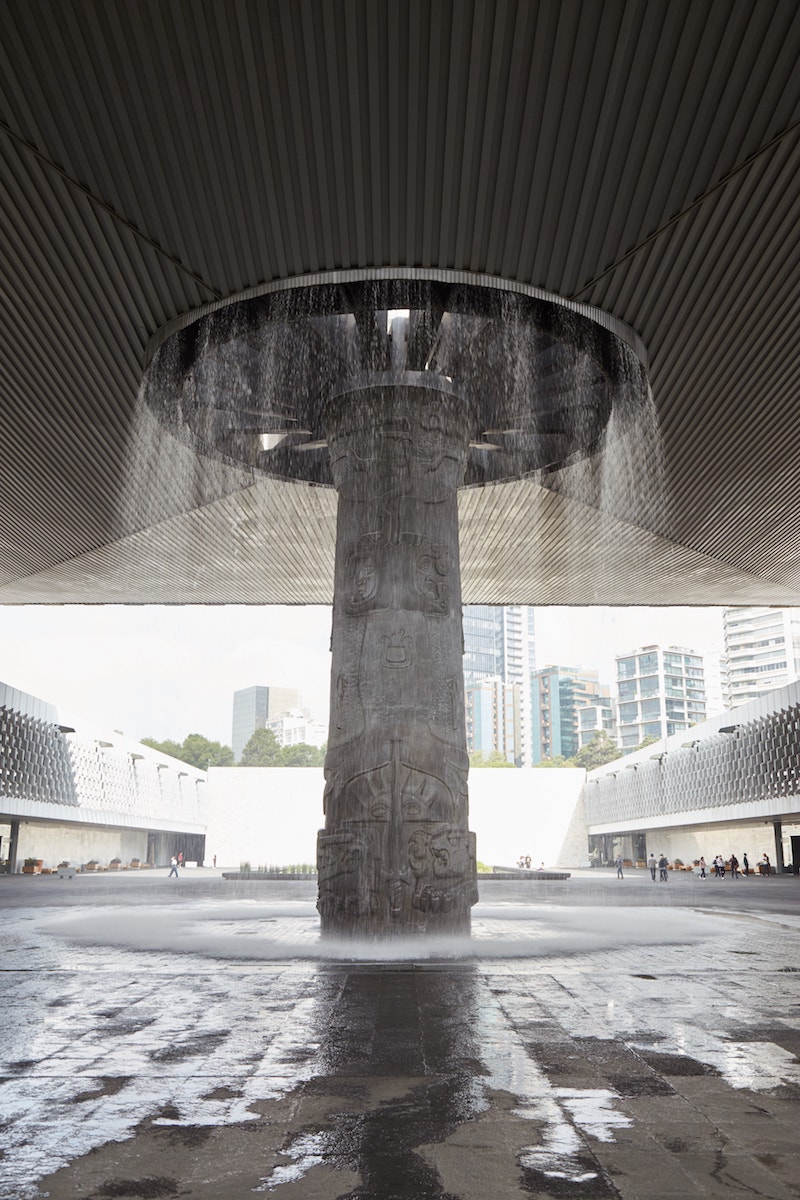
FOOD & DRINKS: Visitors are free to leave the museum and return later in the day with the same ticket. That makes it easy to take a break and refuel with lunch and/or coffee.
The museum is home to an on-site restaurant, but it’s unsurprisingly rather expensive by local standards. Just outside, however, you will find a plethora of affordable food stands.
Across the road, you can also find a Starbucks. And not many visitors realize that just past it is a local coffee shop selling even better (and cheaper) coffee, and with much fewer customers.
Entering the Museum
Even before stepping inside the museum, you’ll encounter the largest piece of its collection. The Monolith of Tlaloc, carved in the likeness of the ancient Mesoamerican rain deity, was found in neighboring Mexico state, near the base of Mount Tlaloc itself.


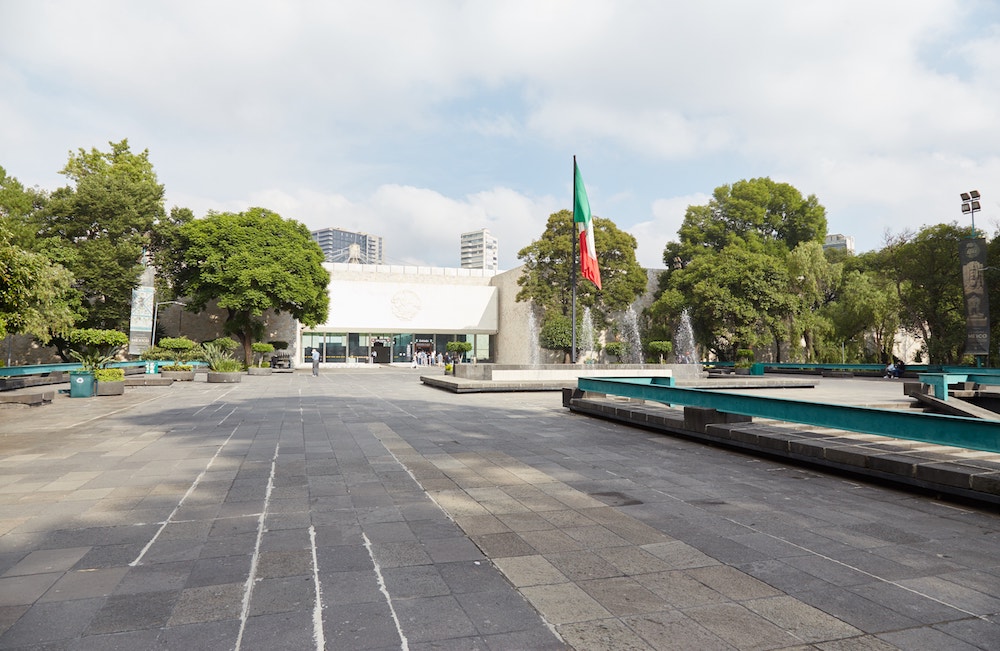
Discovered underground in the 1800s, it was eventually moved to Mexico City in 1963 in time for the museum’s grand opening. As it stands at over 7 m high and weighs 168 tons, moving it here was no easy feat.
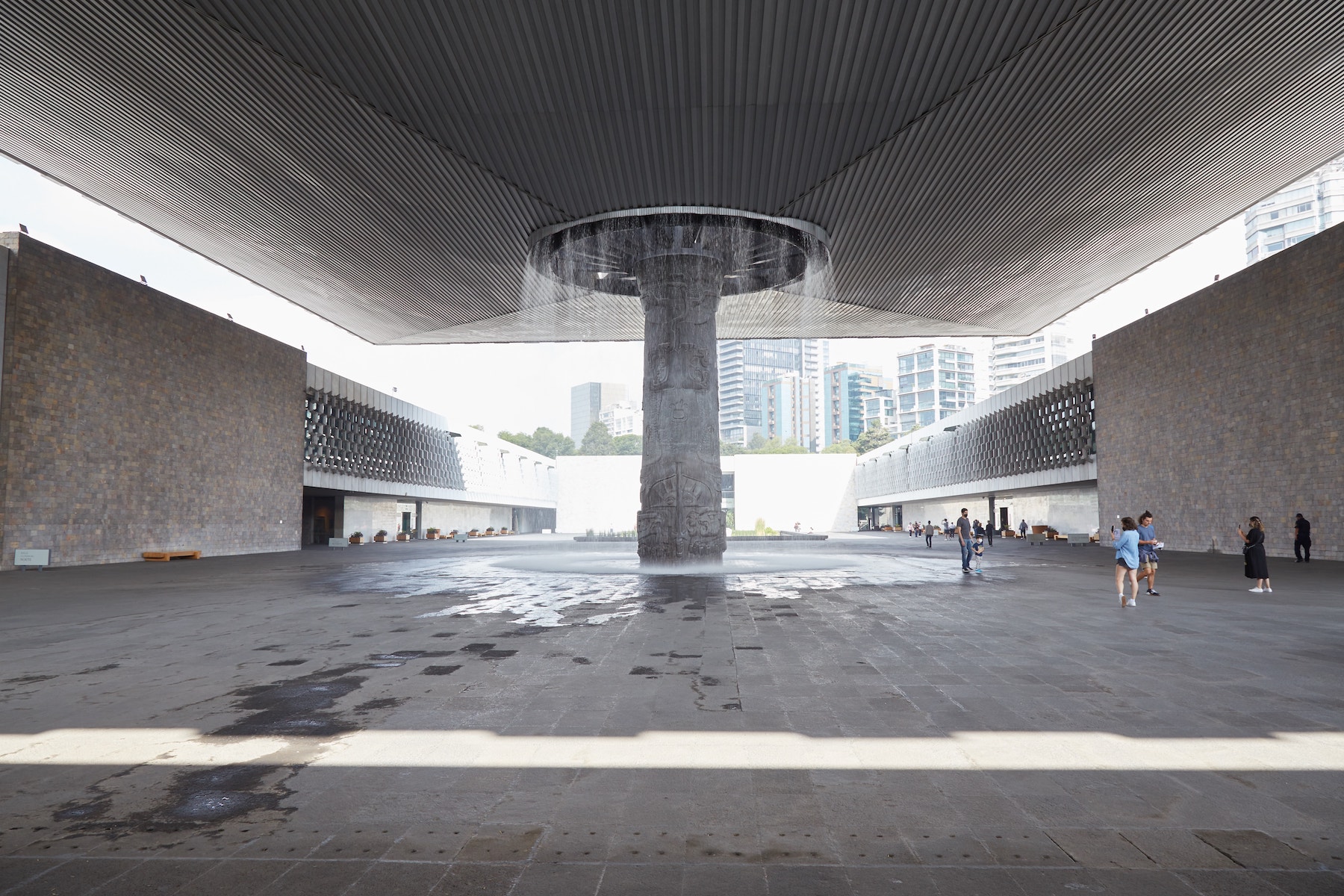
After purchasing your ticket, you’ll walk through a door taking you to the museum’s spacious central courtyard. It’s from here that you can access all of the main exhibits. But as mentioned above, avoid stepping inside the first one you see on your left (Cultures of the Pacific and North).
Instead, we’ll be covering each exhibit in the order recommended for most people visiting the National Museum of Anthropology for the first time.


Teotihuacan
While, as we’ll cover shortly, the ‘mother civilization’ of Mesoamerica was the Olmec, Teotihuacan, which thrived from 100 BC- 650 AD, was the region’s first major metropolis.
Teotihuacan was a culturally diverse city, with living quarters for immigrants from all over Mesoamerica. As such, we still know relatively little about the native inhabitants.
In any case, the term ‘Teotihuacan’ also refers to the culture which developed in the city and its small empire – one that would strongly influence subsequent civilizations for centuries to come.

The exhibit starts with a brief history of some of the earliest cultures in Central Mexico before Teotihuacan’s emergence (such as Cuicuilco, among others). You’ll then learn about the origins of the fascinating city of Teotihuacan, as well as its art, architecture and cultural traditions.
Teotihuacan’s pyramids, in fact, are both some of the earliest and the largest in Mexico. They’re even some of the world’s largest outside of Egypt!


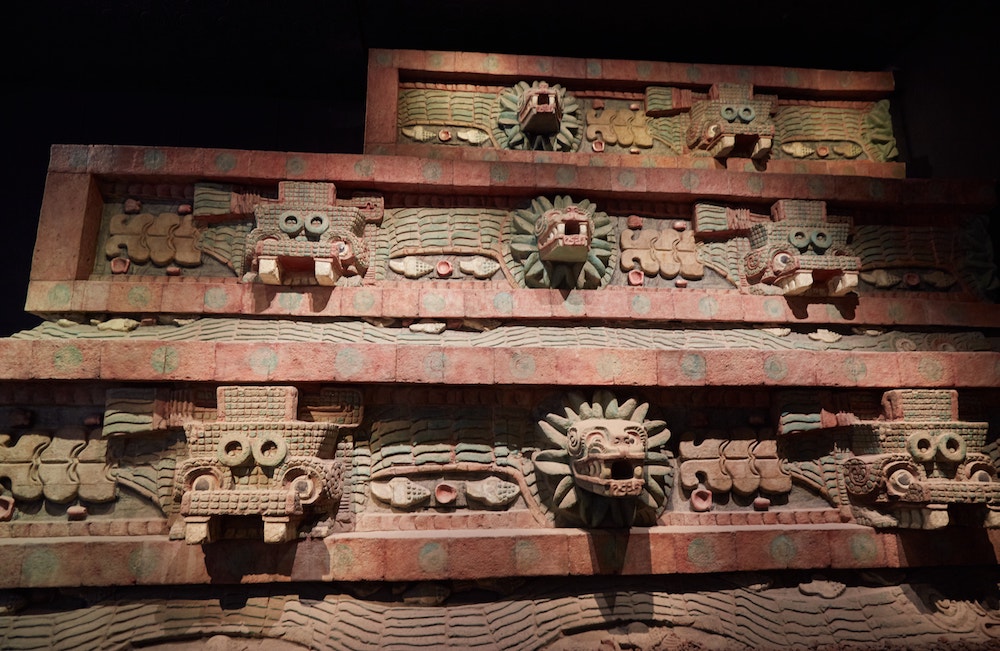
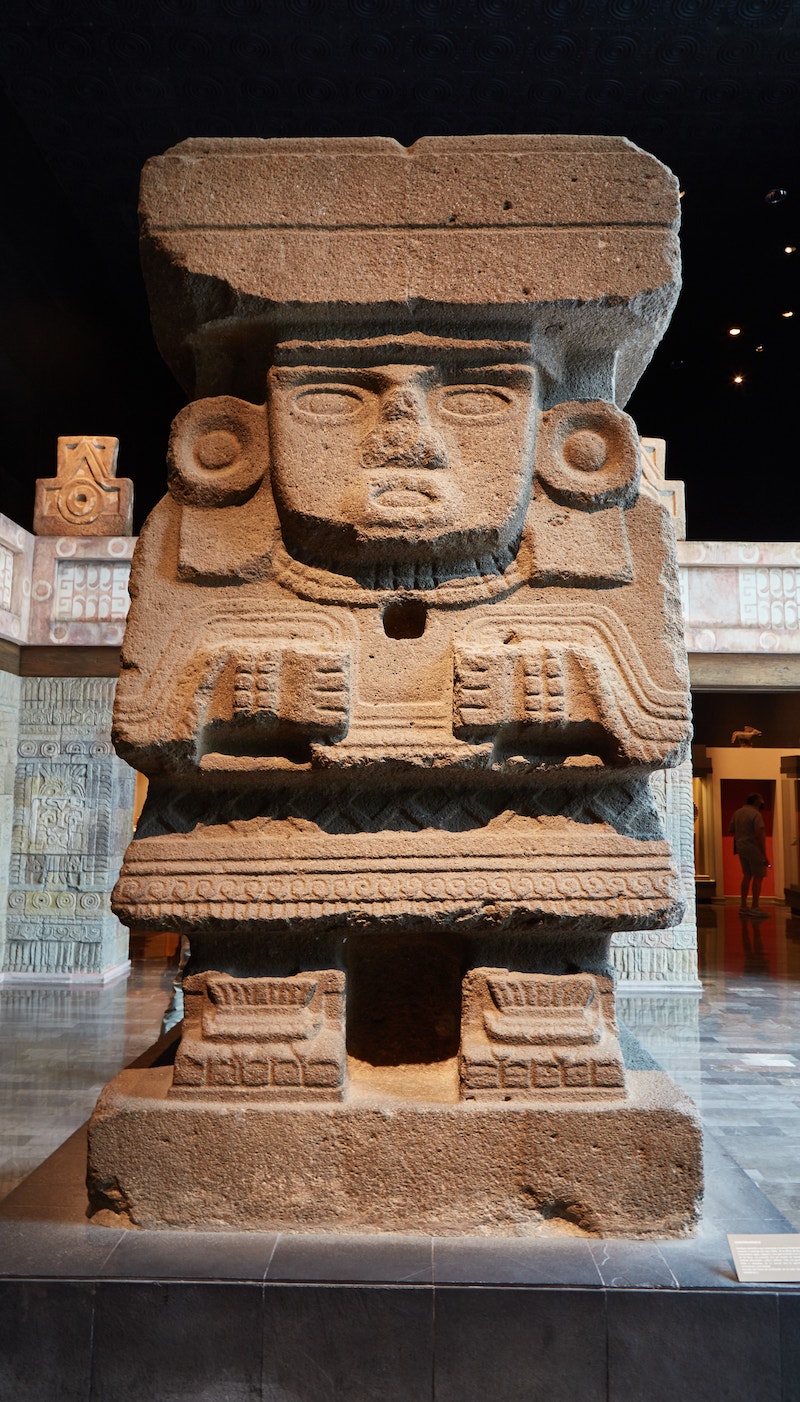
As you’ll notice as you tour the National Museum of Anthropology, many exhibits feature a combination of original artifacts and replicas of certain structures. It’s usually easy to tell which is which, though.
In addition to a reproduction of the elaborate facade of the Pyramid of Quetzalcoatl, a few Teotihuacan structures have been recreated for visitors to walk through.

One such replica is that of a former apartment compound, completely covered in Teotihuacan-style frescoes. As a surprising amount of the city’s murals have survived intact, we have a good idea of how their buildings were painted.
You’ll also find a replica of an ancient Tlaloc temple, complete with many original artifacts. Tlaloc was strongly revered at Teotihuacan and would continue to be worshipped all the way up until the arrival of the Spanish.


Many exhibits at the museum also have additional outdoor sections which usually contain models or full-scale replicas of ancient structures. And stepping outside, you’ll find a model of Teotihuacan.
But as Teotihuacan is an easy day trip from Mexico City, don’t leave the region without seeing it for yourself!

Some of the major exhibits at the National Museum of Anthropology are connected, with one flowing into the next seamlessly. And this is the case here. Without reentering the central courtyard, you’ll soon find yourself in the Toltec and Epiclassic section.
The Toltec & Epiclassic
After Teotihuacan’s downfall, numerous city-states sprang up in its wake during a period we now call the Epiclassic. While not nearly as well-known to the average tourist, a lot of these post-Teotihuacan ruins, such as Xochicalco, Cacaxtla and Cantona, are among Mexico’s finest archaeological sites.
You’ll find brief bilingual histories of a number of these city-states, along with an assortment of artifacts from each.
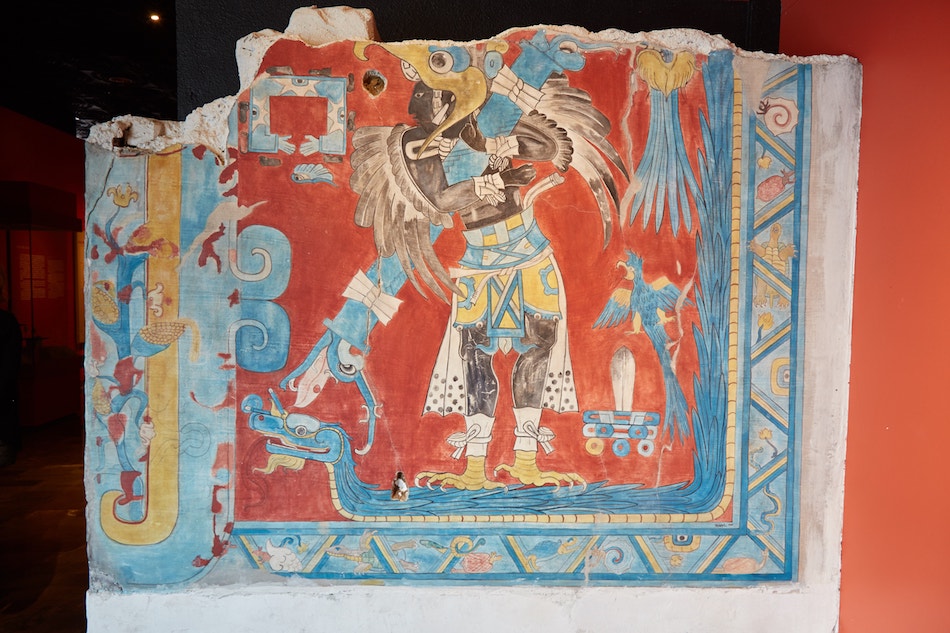

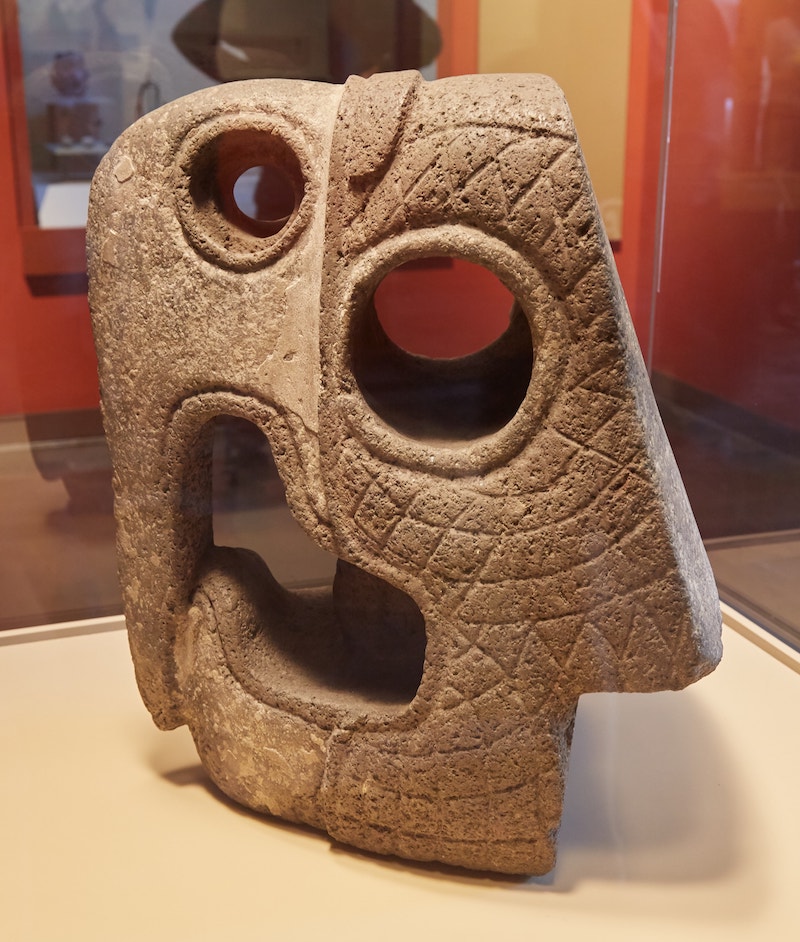
What immediately follows is the section dedicated to the Toltecs – the next great civilization to leave their mark on Central Mexico (and beyond). The Toltecs were based out of a city called Tula, which is also reachable as day trip from Mexico City.
As it can be difficult to distinguish historical accounts from myth, we still don’t know that much about the origins of the Toltec Empire. But they left behind plenty of distinctly Toltec objects – both at Tula and at cities spread across Mexico.
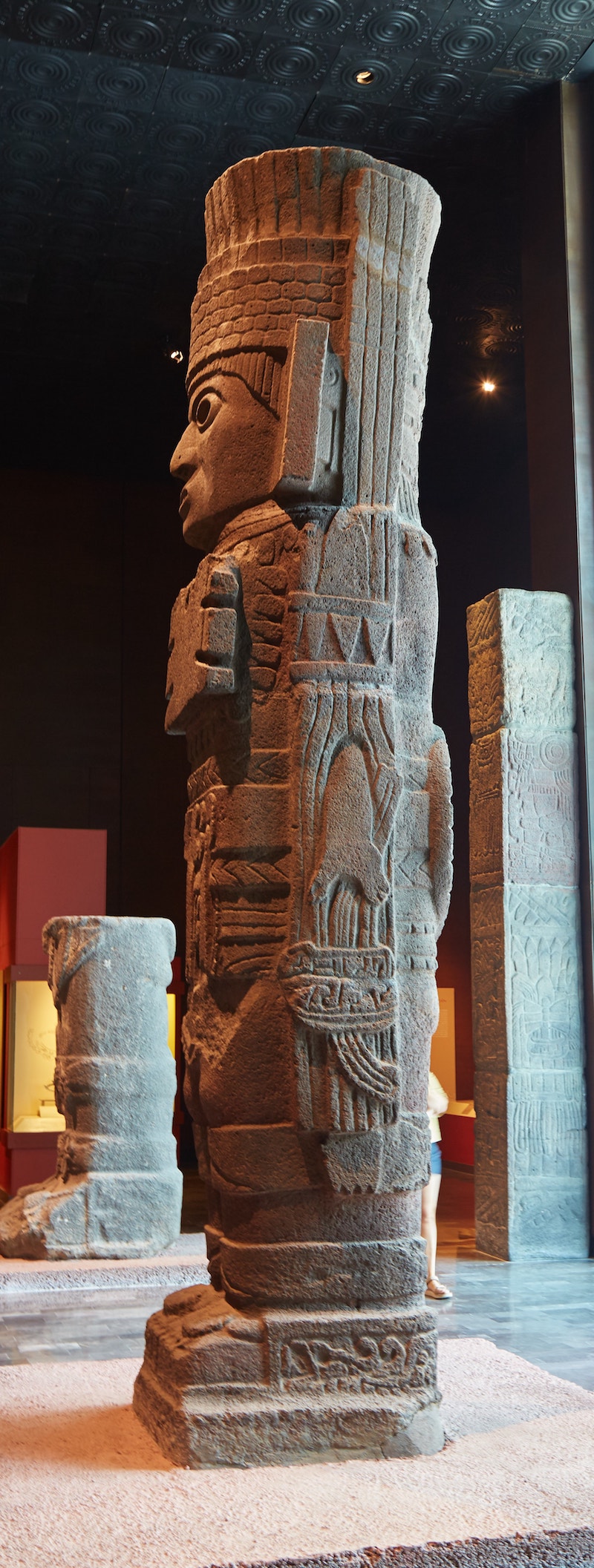


Tula’s most iconic sculptures are its towering ‘Atlantean’ statues. Carved to represent warriors, they stand 4.6 m high and originally held up a temple atop Tula’s main pyramid.
While three of the four originals remain in their original spot, one, which has been swapped out with a replica, now stands at the museum.
Another distinctly Toltec artifact was the chac mool, which depict a reclining figure and was likely used to place religious offerings. Many have been discovered throughout the former Toltec Empire, with some even found as far away as the Mayan city of Chichén Itzá!

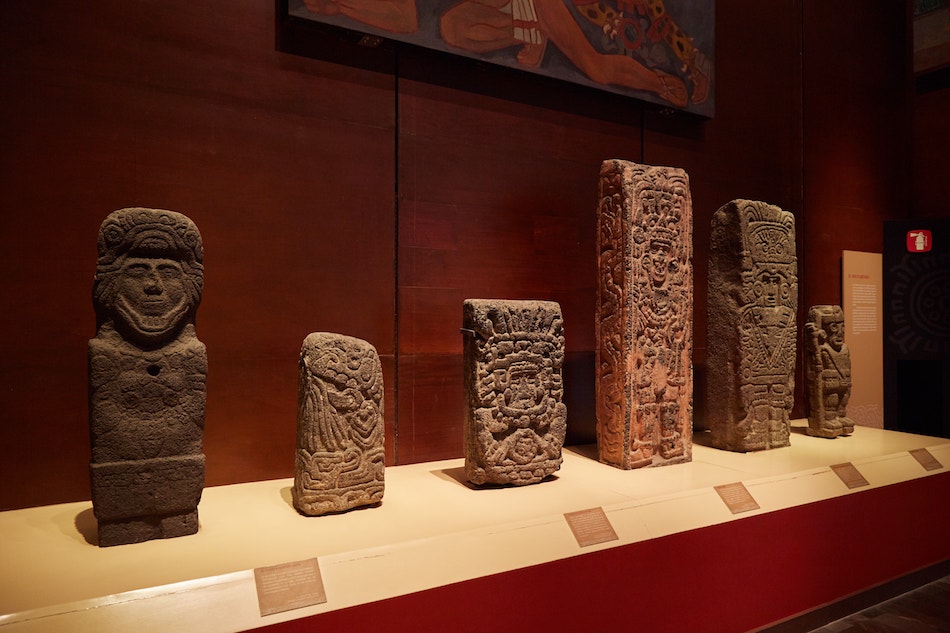
Maya
Next, it would be good idea to head across the courtyard to the Maya exhibit. Situated on the opposite end of Mesoamerica, Mayan history overlaps with that of Teotihuacan, the Epiclassic period and the Toltec Empire.
Even if you won’t be traveling to that region during this trip, the Maya section is arguably the National Museum of Anthropology’s most impressive exhibit and is a must-see for everyone.
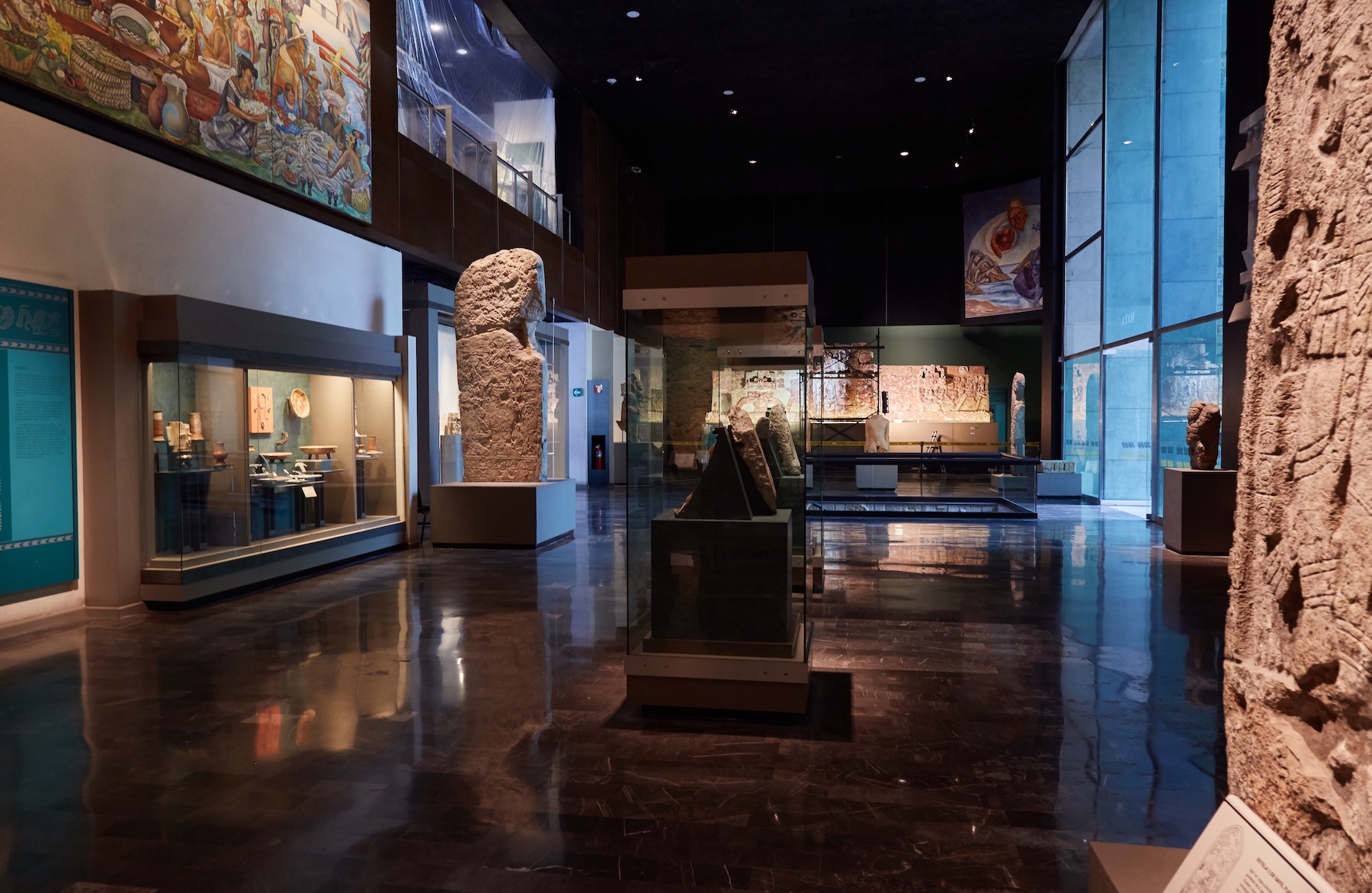


No unified Mayan Empire ever existed. Rather, the Mayan world was divided up into a multitude of city-states that were often at war with one another. But much like the city-states of ancient Greece, they spoke the same language and worshipped the same gods.
As Mayan cities were so spread out, various different art and architectural styles developed throughout the Mayan world. And this is something you can get a sense of while visiting the National Museum of Anthropology.




You’ll find beautiful stelae from Yaxchilan (Chiapas) and Calakmul (Campeche), a recreation of a Puuc-style temple (Yucatán), artifacts from Comalcalco (Tabasco), and ball court objects from Toniná (Chiapas).
A major highlight of the Maya exhibit is the collection of tomb findings of Pakal the Great of Palenque (Chiapas), together with a replica of the original tomb. Fittingly, you can find them in a special underground area.
Outside, meanwhile, are more replicas, such as a recreation of a Chenes-style temple adorned with the face of an Earth Monster, along with recreations of the stunning mural paintings of Bonampak (Chiapas).




The Mayan exhibit then continues with the Postclassic era (900-1200 AD), when cities like Chichén Itzá and Mayapan dominated. While on display in a separate temporary exhibit during my visit, the National Museum of Anthropology is also home to the mysterious Toltec-style chac mool found at Chichén Itzá.
Even after the collapse of the great Mayan cities, the civilization persisted, largely along the coast. And you’ll find a few artifacts from some of last major Mayan centers, such as Tulum and Cozumel.


The Gulf Coast
Ordinarily, it would make most sense to start with the Olmecs, the Mesoamerican ‘mother civilization’ who thrived from around 1600-350 BC. It was the Olmecs who started things like the Mesoamerican ball game, pyramid-building, jade masks and the intricate Mesoamerican calendar system.
But at the National Museum of Anthropology, the Olmecs are lumped together with various unrelated cultures who appeared in the general Gulf Coast region.

It’s also worth noting that the Gulf Coast region already has two amazing archaeology museums that focus on the Olmec – Parque Museo La Venta in Tabasco and the Xalapa Museum of Anthropology in the state of Veracruz.
As most of the main Olmec artifacts are at either one of those museums, this exhibit can feel a bit lacking. Nevertheless, it’s still home to several of the most important Olmec artifacts ever discovered.
While most are still in the Gulf region, here you’ll find a colossal basalt head for which the Olmecs are most known. This one was found in San Lorenzo, Veracruz.




Other highlights include collections of jade artifacts, monkey sculptures and figurines of babies – a common motif in Olmec art, perhaps used to symbolize the continuation of the royal lineage.
One of the most famous Olmec pieces ever found is that of the ‘wrestler.’ Discovered in the state of Veracruz, it shows how adept the Olmecs were at carving the human form, even if they generally preferred more of an abstract style.
Other important findings from La Venta, Tabasco include Monument 19, the first depiction of the Plumed Serpent, and Offering 4, which consists of no less than 16 figurines.
The Olmec section then ends rather abruptly, and you’ll soon find yourself in the general ‘Gulf Coast’ section. While every later Mesoamerican civilization could trace aspects of their culture to the Olmecs, the later Gulf Coast groups were unlikely to have been direct descendants.

Today, the best-known archaeological site in the Gulf Coast region is that of El Tajín in northern Veracruz. And as one might expect, the National Museum of Anthropology contains some of its artifacts. But not quite as many as one would expect.



The major groups which inhabited the Gulf Coast after the Olmecs include the Huastecs and the Totonacs, and you’ll find a plethora of sculptures and artifacts from each.
Notably, it was the Totonacs of Veracruz who aided the Spanish in the conquest, as they were willing to do anything to rid themselves of Aztec domination.



In the outdoor section, you’ll find interesting replicas of tombs discovered in Veracruz, including the unique stone graves of Quiahuiztlán.
Oaxaca
When discussing the great civilizations of Mesoamerica, the region of Oaxaca often gets overlooked. But that’s a mistake, as the Zapotecs, the builders of the great hilltop city of Monte Albán, were one of Mexico’s oldest and most influential civilizations.
Unsurprisingly, a large portion of the Oaxaca exhibit is dedicated to Monte Albán, which thrived from around 100 BC-800 AD. You’ll find numerous artifacts and stelae from the city, together with comprehensive descriptions of Monte Alban’s numerous historical eras.



Another major highlight of this exhibit is the multitude of findings from the tombs of Zaachila, not far from Oaxaca city. You’ll also find artifacts from sites like Yagul and Atzompa as well.



Moving along, you’ll find yet more artifacts from Monte Albán, including a jade bat mask and a full-scale reproduction of Tomb 105.
Eventually, the Oaxaca region would be invaded by a group known as the Mixtecs, who’d take over most of the major Zapotec cities. As such, you’ll find plenty of Mixtec artifacts on display here as well.

The Mixtecs were known for creating colorful codices, many of which have survived in an excellent state of preservation. While much of their true meaning has been lost, modern visitors can still appreciate their vivid colors and mysterious symbols.

Mexica (Aztec)
While the top artifacts of the Zapotecs, Olmecs and Maya are divided amongst various museums throughout Mexico, nearly all of the top Aztec artifacts can be found in Mexico City – both here and at the nearby Templo Mayor Museum.
And the reason for that is simple. The Mexica people, who journeyed from the north to Central Mexico, set up base on the island of Tenochtitlan. The Spanish would later destroy the city and establish what we now call Mexico City.


The Mexica were primarily known as a warlike people who were largely concerned with expansion and conquest. But as evidenced by this exhibit, they also created exquisite art.
This is largely because they coopted many of the artistic motifs of the cultures that came before them. They especially revered past civilizations like the Teotihuacanos and Toltecs, both of which heavily influenced the Aztec style.



The Mexica exhibit is perhaps the most densely packed exhibit of them all, and covering all of the highlights here is impossible. Some pieces to look out for, though, include the stunning jaguar sculpture of Ocelotlcuauhxicalli and the intricately carved sacrificial altars.
You’ll also find scale models of things like Templo Mayor, the prominent Aztec temple (the ruins of which can be visited in Mexico City), and an imagining of the bustling market of Tlatelolco (also in Mexico City).

Visitors to the National Museum of Anthropology can also find the iconic Sun Stone – one of the most recognized Mesoamerican artifacts. It was discovered in 1790 near the Zocalo, Mexico City’s public square.
As it depicts aspects of the Aztec calendar, there’s still debate over whether it was merely a calendar or also used for things like human sacrifice.

Other Mexica/Aztec highlights worth mentioning include the imposing and surreal sculpture of the goddess Coatlicue. While much smaller, one of the most unique pieces here is a monkey vase completely carved out of obsidian.
As mentioned, you can also find additional Aztec artifacts at the Templo Mayor Museum in the Centro Historico district.





Even More
The exhibits covered above should take up most of your day. But if you still have some energy left over, or want to come back another day to learn more, here are some additional exhibits to check out.
West Mexico & North Mexico
As the name suggests, this joint exhibit focuses on the Pacific region and the desert regions of the north. Frankly speaking, archaeological sites in these regions are sparse, which is why these exhibits are some of the museum’s least essential.
Among the most well-known sites featured here, however, include Tzintzuntzan and other former Tarascan Empire cities of Michoacán.


You’ll also learn about Paquimé in the far north of the border state of Chihuaha. It actually shares more in common with the ancient cultures of the US Southwest than those of Mesoamerica.
Some of the oldest archaeological sites in Mexico area actually cave paintings from Baja California, which you can find replicas of at the museum.


Pueblos Indios (2nd Floor)
As mentioned above, the second floor of the museum is dedicated to ethnology. The exhibitions are divided by region, and you’ll learn about the various folk traditions that have survived into the present.
While indeed fascinating, the truth is, you can also learn about these things by going to the local museums of each region you visit. That’s why I’d recommend most visitors stick to the bottom floor to focus on seeing one-of-a-kind artifacts.



Special Exhibits
When visiting the National Museum of Anthropology, you may also find a special temporary exhibit. During my most recent trip, I encountered a fascinating exhibit that basically served as a ‘best of’ of some of Mesoamerica’s top pieces.
Presumably, some of the pieces from the main exhibits mentioned above may sometimes get moved to temporary ones depending on the subject matter.

Additional Info
The National Museum of Anthropology is located within Chapultepec Park in the southwest portion of central Mexico City. To get there, you have several different options based on where you’re coming from.
Subway
The closest subway station to the National Museum of Anthropology is Chapultepec on Line 1 (the pink line). At the time of writing however, the entire western half of Line 1 is not running due to renovations.
Therefore, it’s best to confirm whether or not Line 1 is running before your visit to the museum – and to Mexico City, for that matter. Don’t mistakenly book a hotel next to Line 1 if it’s not yet up and running!
While there is currently a shuttle bus alternative, it’s surely a much slower and more crowded option.
Metrobús
If Line 1 of the subway is still down, another option is to take the Metrobús. These special buses have their own lanes on major streets, allowing them to bypass regular traffic.
The closest stop to the museum is the appropriately-titled Antropología stop on Metrobús Line 7.
Just be a bit cautious before riding the Metrobús. While I had no problems taking it to the museum, I experienced issues on several other occasions. For example, sometimes my bus would entirely switch lines mid-route! Other times, the bus would just randomly stop and tell everyone to get out.
It’s always best to keep your eye on Google Maps to make sure your bus is indeed headed where you want it to go.
Uber
Uber is a great way to get around Mexican cities, including the capital. And you don’t have to worry about potential scams like you do with regular taxis.
As well-connected as Mexico City is, it’s so massive and crowded that getting around by public transport is often time-consuming and frustrating.
I often found myself taking Uber to save time and avoid stress. Fortunately, Uber prices in Mexico City are often quite reasonable – even compared with smaller Mexican cities.
On Foot
If you’re staying somewhere near Paseo de la Reforma, you may be able to simply walk to Chapultepec Park and the museum.
Mexico City is an incredibly massive city of nearly 10 million people. And its various tourist attractions are scattered throughout, making choosing where to stay a challenge. But here are a few suggestions to help you decide:
Centro Histórico
As the name suggests, this is the historical part of the city built by the Spanish. But they constructed it over the former Aztec capital of Tenochtitlan, even filling in the lake around it. As such, it’s the district where you’re going to find most the significant landmarks from both the colonial and pre-Hispanic era.
Just keep in mind that at the time of writing, Line 1 of the subway which runs through this area is down for maintenance.
A highly-rated high-end hotel here is Círculo Mexicano, while popular mid-range options include Hotel Metropol and Hotel Marlowe.
Those on a stricter budget, meanwhile should consider Hotel Sonno Plaza Allende.
Roma/Condesa
The Roma and Condesa neighborhoods, which are adjacent to one another, are widely considered Mexico City’s hippest districts. They’re also hugely popular with foreigners, so it may be a good place to stay if you’re not comfortable speaking Spanish.
On the higher end, Roso Guest House is conveniently located and includes free breakfast.
Stanza Hotel and Hotel Marbella are highly-rated mid-range options, while those on a budget should consider Anys Hostal.
Other popular neighborhoods include Coyoacán, home to the Frida Kahlo Museum, and just an interesting place to wander around in general. But while worth visiting, it’s not a very convenient base from which to explore the rest of the city.
If you plan on taking a lot of day trips, another good option is to stay near one of the city’s main bus stations. The problem is, however, that the city has no less than FOUR main stations – to the west, north, east and south of the center.
While there’s no perfect option, you could get a head start on visiting Teotihuacan by staying somewhere near the northern station (Autobuses del Norte).
If visiting the National Museum of Anthropology on your own sounds overwhelming, you may want to consider a tour. This tour is very highly-rated, but like many of the tours available, it only lasts a few hours.

Pin It!

[…] of trying to remember what I could and searching for alternatives to the glitchy main site, I found this post on another site which is way more educated and actually informative about the museum, if that’s what […]